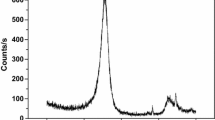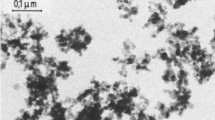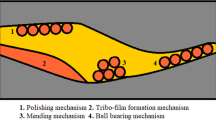Abstract
In this paper, the contribution of dispersed graphene nanoparticles in graphene-gear oil nanolubricant has been analyzed. Synthesis of nanolubricant has been performed using the two-step method. The nanoparticles have been dispersed in the range of 0.03–1.8% by volume in industrial gear oil (SAE EP90). Viscosity and density of nanolubricant are measured by using Stabinger viscometer (SVM 3000, M/S Anton-Paar). Rheological properties have been experimentally tested in the temperature range of 20–80 °C, and the results have been compared with theoretically available models in open literature. The performance characteristics of nanolubricants in hydrodynamic lubrication regime have been evaluated by considering the standard Reynolds equation. For this purpose, the geometry of an infinite Rayleigh step slider bearing (one dimension) is considered with defined boundary conditions. Finite difference method (FDM) is used to obtain the solution of boundary value problem. Results confirm that the dispersion of graphene nanoparticles in gear oil enhances the performance of lubrication.
Access provided by Autonomous University of Puebla. Download conference paper PDF
Similar content being viewed by others
Keywords
1 Introduction
Conservation of energy is a major concern for a sustained ecosystem. The main reason for energy loss in any mechanical system is due to wear of its components which can be reduced by efficient lubrication. Efficient lubrication is basically an ideal selection of base lubricant and proper additives. With the advancement of technology, researchers have come up with newer lubricants comprising of nanoparticles as additives dispersed in base lubricants termed as ‘Nanolubricants’. Nanolubricants are found to have enhanced thermophysical, rheological and tribological properties over conventional lubricants. Adding nanoparticles in traditional lubricants for enhancing tribological and thermal properties in recent years is extensively studied [1]. Kotia et al. [2] observed that Al2O3 nanoparticles in industrial gear oil (SAE EP-90) enhanced viscosity to 1.7 times of base lubricant with a concentration of 2% by volume of nanoparticles. Aberoumand et al. [3] expressed viscosity as an important consideration for industrial application and presented a correlation for the same. Berman et al. [4] introduced graphene as a new emerging potential additive to the lubricating oils. Graphene nanoparticles with their sheet-like structure enhance surface area, thereby reducing metal to metal contact resulting in transmitting heat more efficiently [5]. Yang et al. [6] confirmed that graphene-based lubricants remarkably reduce the wear and coefficient of friction by 91 and 53%, respectively, compared to base lubricant. Adding graphene nanoparticles in base oils has indicated remarkable increment in heat transfer properties within optimum concentration range beyond which agglomeration takes place leading to high friction and wear [7, 8]. Furthermore, many noteworthy works have been conducted regarding the enhancement of tribological properties of lubricants by adding graphene nanoparticles [9, 10].
In this paper, the nanolubricant has been prepared by dispersing graphene nanoparticles in gear oil (SAE EP90). Rheological and thermophysical properties at varying temperature and particle volume fraction are experimentally evaluated. Performance parameters considering Rayleigh step bearing geometry are numerically obtained using finite difference method.
2 Governing Equations
2.1 Reynolds Equation
A 1D Reynolds equation for incompressible flow is given as:
Where h denotes the film thickness, p denotes the pressure of the nanolubricant film, \( \rho \) and \( \eta \) denotes the density and viscosity of the nanolubricant, respectively, and U is the sliding velocity of the moving surface.
In Eq. (1), the parameters have been presented in the non-dimensional form as:
where X = \( \frac{x}{l} \), P = \( \frac{{ph_{2}^{2} }}{{6Ul\eta_{0} }} \), H = \( \frac{h}{{h_{2} }} \), \( \rho^{*} = \frac{\rho }{{\rho_{0} }} \), \( \eta^{*} = \frac{\eta }{{\eta_{0} }}. \)
2.2 Load Carrying Capacity
Load carrying capacity per unit width (W) of the plate is given as:
3 Modelling
A schematic representation of the geometry of Rayleigh step bearing is shown in Fig. 1. The sliding direction is along the x-coordinate considering the location of origin at the entry. The flow of nanolubricant is assumed to take place from left to right. The surface of the pad has a step zone with initial film thickness h1 and final film thickness along a land zone as h2.
The boundary conditions used herein are: At entry, P = 0 for X = 0, P = Pc at X = L1/L, and at exit, P = 0 for X = 1.
4 Experimental Procedures
Graphene nanoparticles, sheet thickness 2–5 nm, 2–4 layers with surface area 380 m2/g, density 2.2 g/ml have been dispersed in industrial gear oil (SAE EP90). Samples were prepared comprising of plain gear oil and graphene-gear oil nanolubricants with varying particle concentration of 0.3, 0.6, 0.9, 1.2, 1.5 and 1.8% by volume fractions. The nanoparticles appropriate weight (W) is calculated using the following Equation [5] in terms of volume fraction \( \left( \phi \right) \):
where \( '\rho ' \), \( 'p' \) and \( 'l' \) represent particle density, nanoparticle and base lubricant, respectively. Digital weighing balance (least count 0.001 mg) was used to obtain the accurate measure of mass for the nanoparticles. Nanoparticles in base lubricants were uniformly mixed by magnetic stirring for 30 min at 600 rpm followed by half an hour ultra-sonication (20 kHz) to de-agglomerate the nanoparticles. The following table shows the details of instruments used for measuring density, viscosity and shear variations (Table 1).
All the readings from these instruments were recorded in Dhanbad at an estimated height of 232 m above mean sea level.
5 Results and Discussions
5.1 Density and Viscosity Variation
Figure 2 represents the density plots of graphene/EP-90 nanolubricant with temperature at varying nanoparticle volume fraction. The density decreases with temperature in all cases following a constant gradient at all particle concentrations. Error bars are incorporated to include uncertainty in the analysis. The temperature range (20–80 °C) has been set to get the nature of the data points. With increasing temperature, the graph approaches a constant value asymptotically. The data points are measured with an estimated maximum uncertainty within 3%.
Figure 3 represents the viscosity–temperature variation of graphene/EP-90 nanolubricant with varying concentration of nanoparticles. The dependence of viscosity of nanolubricant with temperature affirms asymptotic nature as a result of weakening inter-molecular adhesion force with increasing temperature. Measurements are reported with an estimated maximum uncertainty within 2% (Table 2).
Figure 4 represents the relative viscosity plots of graphene/EP-90 nanolubricant between theoretical models and experimental data. It can be seen that with increasing particle concentration, the relative viscosity also increases. The viscosity enhancement of nanolubricant respect to base lubricant is about 22–32% with varying particle concentration of 0.3–1.8%. MATLAB (2014) is used to develop a correlation between relative viscosity and volume fraction as expressed below:
5.2 Rheological Variations
Figure 5 depicts the shear stress with shear rate variation of graphene/EP-90 nanolubricant at varying concentration of graphene at 30 °C. It is evident that at relatively low volume fraction, the variation is almost linear indicating Newtonian behaviour, while at higher volume fraction, this variation approaches towards nonlinearity showing non-Newtonian nature. Figure 6 represents the viscosity–shear rate trends of graphene/EP-90 nanolubricant at varying concentrations. It confirms that nanolubricant exhibits significant shear thinning characteristics at higher volume fraction and viscosity declines asymptotically at a higher shear rate.
5.3 Performance Curves
To evaluate the performance characteristics in the step bearing with nanolubricant, the following geometrical inputs have been used for the study (Table 3).
Figure 7 shows the pressure distribution with non-dimensional length over the width of the slider. It is evident that the pressure profile shows an increasing trend with volume fractions in all cases. The peak pressure is achieved at the common point of step and zone land. Figure 8 depicts the profile of maximum load-carrying capacity with volume fraction at 30 °C and found to increase with volume fraction under optimum film thickness ratio condition, i.e. 1.86.
6 Conclusions
In this present work, the effects of dispersing graphene nanoparticles in gear oil (SAE EP-90) have been experimentally investigated. Improvement in rheological properties have been obtained and compared with previous research works. Shear-thinning behaviour has been observed with increasing nanoparticle volume fraction. The performance characteristics of nanolubricants in hydrodynamic lubrication regime assuming the geometry of 1D Rayleigh step bearing have been obtained by considering the standard Reynolds equation. Basic inputs from the earlier study have been used for calculating the performance parameters. It has been observed that the dispersion of graphene enhances the performance of lubrication.
Abbreviations
- X :
-
Non-dimensional pad width
- l :
-
Pad width
- P :
-
Non-dimensional pressure of the nanolubricant film
- h(x):
-
Thickness of nanolubricant film
- H :
-
Non-dimensional film thickness
- \( \eta_{0} \) :
-
Viscosity at p = 0 (Pa s)
- \( \rho_{0} \) :
-
Density at p = 0 (kg/m3)
- \( \rho^{*} \) :
-
Non-dimensional density
- \( \eta^{*} \) :
-
Non-dimensional viscosity
References
Rajendhran, N., Palanisamy, S., Shyma, A. P., Venkatachalam, R. (2018). Enhancing the thermophysical and tribological performance of gear oil using Ni-promoted ultrathin MoS2 nanocomposites. Tribology International. https://doi.org/1.20180.106/j.triboint.2018.03.030.
Kotia, A., & Ghosh, S. K. (2015). Experimental analysis for rheological properties of aluminium oxide (Al2O3)/gear oil (SAE EP-90) nanolubricant used in HEMM. Indian Lubricants Tribology, 67, 600–605.
Aberoumand, S., Jafarimoghaddam, A., Moravej, M., Aberoumand, H., & Javaherdeh, K. (2016). Experimental study on the rheological behavior of silver-heat transfer oil nanofluid and suggesting two empirical based correlations for thermal conductivity and viscosity of oil based nanofluids. Applied Thermal Engineering, 101, 362–372.
Berman, D., Erdemir, A., & Sumant, A. V. (2014). Graphene: a new emerging lubricant. Materials Today, 17(1), 31–42.
Zhao, C., Chen, Y. K., & Ren, G. (2013). A study of tribological properties of water-based ceria nanofluids. Tribology Transactions, 56(2), 275–283.
Yang, J., et al. (2017). Synthesis of the liquid-like graphene with excellent tribological properties. Tribology International, 105, 118–124.
Rasheed, A. K., Khalid, M., Javeed, A., Rashmi, W., Gupta, T. C. S. M., & Chan, A. (2016). Heat transfer and tribological performance of graphene nanolubricant in an internal combustion engine. Tribology International, 103, 504–515.
Lin, Y., et al. (2015). Wear and friction characteristics of surface-modified aluminium alloys. International Journal of Surface Science and Engineering, 9(2–3), 109–123.
Rasheed, A. K., & Khalida, M. (2016). Study of graphene nanolubricant using thermogravimetric analysis. Journal of Materials Research, 31(13), 1939–1946.
Lin, J., Wang, L., & Chen, G. (2011). Modification of graphene platelets and their tribological properties as a lubricant additive. Tribology Letters, 41(1), 209–215.
Einstein, A. (1905). A new method for determination of the molecular dimensions. Annalen der Physik, 19(2), 89–306.
Brinkman, H. C. (1952). The viscosity of concentrated suspensions and solution. Journal of Chemical Physics, 20(4), 571–581.
Lundgren, T. S. (1972). Slow flow through stationary random beds and suspensions of spheres. Journal of Fluid Mechanics, 51(2), 273–299.
Wang, B. X., Zhou, L. P., & Peng, X. F. (2003). A fractal model for predicting the effective thermal conductivity of liquid with suspension of nano particles. International Journal of Heat and Mass Transfer, 46(11), 2665–2672.
Pak, B. C., & Cho, Y. I. (1998). Hydrodynamic and heat transfer study of dispersed fluids with submicron metallic oxide particles. Experimental Heat Transfer: A Journal of Thermal Energy Generation, Transport, Storage, and Conversion, 11(2), 151–170.
Author information
Authors and Affiliations
Corresponding author
Editor information
Editors and Affiliations
Rights and permissions
Copyright information
© 2021 Springer Nature Singapore Pte Ltd.
About this paper
Cite this paper
Ghosh, G.K., Kotia, A., Kumar, N., Ghosh, S.K. (2021). Performance Evaluation of Graphene-Gear Oil Nanolubricants in Rayleigh Step Bearing. In: Prakash, C., Krolczyk, G., Singh, S., Pramanik, A. (eds) Advances in Metrology and Measurement of Engineering Surfaces . Lecture Notes in Mechanical Engineering. Springer, Singapore. https://doi.org/10.1007/978-981-15-5151-2_11
Download citation
DOI: https://doi.org/10.1007/978-981-15-5151-2_11
Published:
Publisher Name: Springer, Singapore
Print ISBN: 978-981-15-5150-5
Online ISBN: 978-981-15-5151-2
eBook Packages: EngineeringEngineering (R0)












